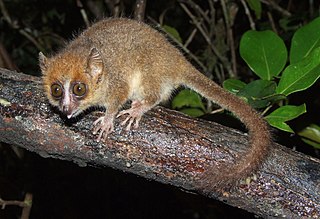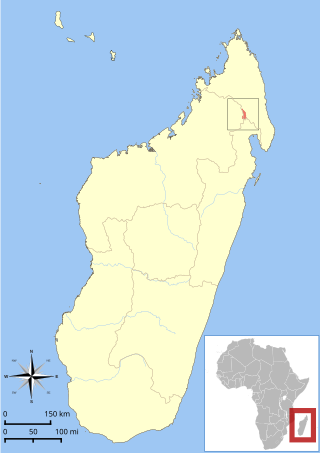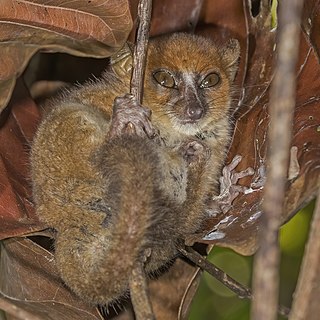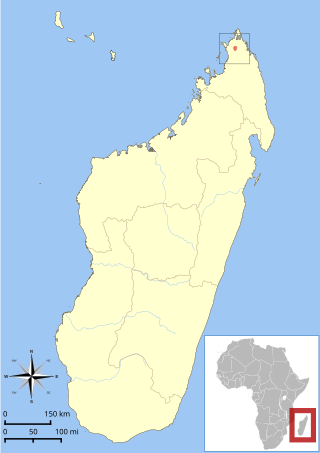
The Cheirogaleidae are the family of strepsirrhine primates containing the various dwarf and mouse lemurs. Like all other lemurs, cheirogaleids live exclusively on the island of Madagascar.

The pygmy mouse lemur, also known as Peters' mouse lemur or dormouse lemur, is a primate weighing only 43–55 g (1.5–1.9 oz); it is the second smallest of the mouse lemurs. Its dorsal side is a rufous-brown colour, and creamy-white ventrally. It lives in dry deciduous forests of western Madagascar. It has been captured in the Tsingy de Bemaraha Nature Reserve, the Andramasy forests north of Belo sur Tsiribihina, and the border of heavily degraded deciduous forest and savanna at Aboalimena. It has also been found in other habitats, in mangroves in two localities.

The Sambirano mouse lemur is a small, recently discovered primate and like the other mouse lemurs can only be found on the island of Madagascar. The dorsal side is both cinnamon and rufous-cinnamon and is grey ventrally. It has vibrissae that are dark in color.

Jolly's mouse lemur is a species of mouse lemur from Mananjary and Kianjavato in Madagascar. The species is named in honor of primatologist Alison Jolly.

Mittermeier's mouse lemur is a species of mouse lemur known only from Anjanaharibe-Sud Special Reserve in Madagascar.

Simmons' mouse lemur is a species of mouse lemur known only from Betampona Special Reserve, Analalava Special Community Reserve near Foulpointe, and Zahamena National Park in Madagascar.

Claire's mouse lemur, or the Nosy Be mouse lemur, is a newly described species of lemur from the genus of the mouse lemurs (Microcebus). It lives on the island Nosy Bé in the Antsiranana province of Madagascar, and on the mainland near the village of Manehoka, including Lokobe Reserve. The scientific type name, mamiratra, comes from Malagasy and means "clear and bright"; this refers the Theodore F. and Claire M. Hubbard Family Foundation, which has contributed to genetic research on Madagascar. This species is closely related to another new species, "M. species nova # 5"; which is related to the Sambirano mouse lemur, Microcebus sambiranensis, and the northern rufous mouse lemur, Microcebus tavaratra.

The reddish-gray mouse lemur also known as the gray-brown mouse lemur or rufous-gray mouse lemur, is a small, solitary-but-social, nocturnal and omnivorous primate from the Western Madagascar in the region around Beza Mahafaly Reserve, north to Lamboharana. Like the other lemur species, the reddish-grey mouse lemur is endemic to Madagascar. They generally live in the drier regions of the island. It is categorized as least concerned in the IUCN Red List.

The mouse lemurs are nocturnal lemurs of the genus Microcebus. Like all lemurs, mouse lemurs are native to Madagascar.

Danfoss's mouse lemur, or the Ambarijeby mouse lemur, is a species of mouse lemur endemic to Madagascar. It lives in western deciduous forest within a limited range between the Sofia River and the Maevarano River. This species has been found in substantial populations in the Ambarijevy, Anjajavy, and Beanamaolo forests in Madagascar. Their lifespan is about 5 years but can live up to 10 years. They are part of the infraorder called lemuriformes which represents 20% of the entire primates diversity and over 60% of the mammalian genera of Madagascar.

MacArthur's mouse lemur, or the Anjiahely mouse lemur, is a species of mouse lemur known only from Makira Natural Park in northeastern Madagascar.

Arnhold's mouse lemur or the Montagne d'Ambre mouse lemur is a species of mouse lemur endemic to Madagascar. Its holotype was first collected on 27 November 2005, and was first described in 2008. According to genetic tests, it is genetically distinct from its closest sister taxa, the Sambirano mouse lemur.

The Bongolava mouse lemur is a species of mouse lemur endemic to Madagascar. It lives in western deciduous forest within a limited range, including Bongolava Forest and Ambodimahabibo Forest between the Sofia River and the Mahajamba River.

Gerp's mouse lemur is a species of mouse lemur known only from the Sahafina Forest in eastern Madagascar, near Mantadia National Park. Its discovery was announced in 2012 by a German and Malagasy research team. The Sahafina Forest had not been studied until 2008 and 2009, when Groupe d'Étude et de Recherche sur les Primates de Madagascar (GERP)—a Malagasy-based research and conservation group for which the lemur is named—inventoried the forest's lemurs.

The Marohita mouse lemur is a species of mouse lemur known only from the Marohita Forest in eastern Madagascar, near the village of Marolambo. Specimens were first collected in December 2003, and its discovery was announced in 2013 along with the Anosy mouse lemur. It is a large mouse lemur, weighing up to 89 g (3.1 oz), and lives within the same area as the Goodman's mouse lemur (M. lehilahytsara), Simmons' mouse lemur (M. simmonsi), and the brown mouse lemur (M. rufus), all four of which are nearly identical in appearance. Its fur is rufous on its back and grayish-beige on its underside. Nothing is known about its behavior. Its conservation status was evaluated as Endangered by the International Union for Conservation of Nature (IUCN) in 2012, before it was formally described, because its only known habitat had severely degraded between 2003 and 2012.

Lemurs' Park is a small botanical garden and lemur reserve covering 5 ha, and is located 22 km (14 mi) southwest of Antananarivo, Madagascar. It was founded around 2000 by Laurent Amouric and Maxime Allorge. Most of its nine lemur species are free-ranging within the park, which also contains more than 70 of Madagascar's endemic plant species. The park is open to the public, offering guided tours as well as standard amenities, a gift shop, and a restaurant. Visitors can arrange transportation between downtown Antananarivo and Lemurs' Park on a private park shuttle.
The Montagne d'Ambre dwarf lemur or Andy Sabin's dwarf lemur is a species of dwarf lemur known only from Amber Mountain National Park and the surrounding area in northern Madagascar. It was identified in 2005, but not formally described until 2015. It is an endangered species, at risk from deforestation and possibly hunting from nearby human populations.
The Bemanasy mouse lemur, Microcebus manitatra, is a species of mouse lemur described in 2016 from Madagascar. It was discovered by a team of researchers at the German Primate Center. It was initially discovered among closely related species such as Madame Berthe's mouse lemur, Boraha mouse lemur, and Ganzhorn's mouse lemur. Morphological similarity made it impossible to identify them as distinct species. A genetic study was done in collaboration with scientists at the University of Kentucky, the Duke Lemur Center and the University of Antananarivo in Madagascar. The mtDNA sequencing revealed that the species was unique.
The Ankarana dwarf lemur or Sheth's dwarf lemur is a species of dwarf lemur, part of the C. medius group, known only from northern Madagascar. It has been found in two reserves as well as two protected areas. It was identified in 2014, but not formally described until 2016. Its conservation status has not been determined, but it is at risk from habitat destruction due to daily resource extraction by local human populations.
















